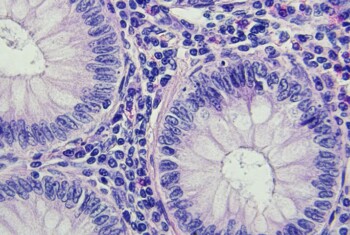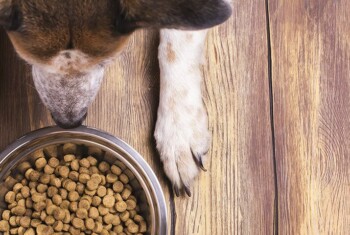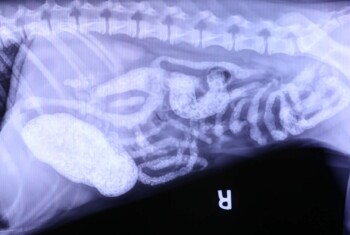Gastrointestinal obstruction: Non-linear foreign bodies.
The gastrointestinal tract consists of a tube that runs from the mouth to the anus. Its function is to digest food and absorb nutrients into the body. The stomach is a dilated part of the GI tract that produces acid, which helps with the initial breakdown of proteins.
The small intestine extends from the stomach to the colon and serves to further break down food into absorbable nutrients. The colon is the reservoir for stool, serves as a water absorber, and is the site where certain vitamins are produced by bacteria. The colon has a larger diameter than the small intestine; therefore, foreign bodies located in the colon usually can be passed with bowel movements.
Nonlinear foreign bodies in the GI tract.
There are two major types of foreign bodies: nonlinear and linear. Examples of nonlinear foreign bodies include balls, toys, bones, rocks and many other bizarre objects that pets are tempted to ingest. Nonlinear foreign bodies cause an intestinal obstruction that prevents gas and fluid from passing down the intestine. Linear foreign bodies include string, rope, thin long socks, pantyhose, thongs and other objects that are long. These potentially can cause a perforation of the intestine.
Signs and diagnosis.
The primary signs of a GI foreign body include vomiting, anorexia, depression and dehydration (mouth becomes less moist and saliva becomes tacky). Diarrhea is not a common sign associated with a foreign body, as the object will prevent fluid from passing through the intestine. Patients who develop blood poisoning (bacteremia) from the foreign body may develop diarrhea. Crying, whimpering, not willing to lie down or assuming a hunched or praying position (down on the forelimbs and up on the hind limbs) may be a sign of abdominal pain.
The diagnosis of a gastrointestinal foreign body generally is made with abdominal x-rays. In some cases, the veterinarian will be able to clearly determine that a GI foreign body is present. Yet other cases may not show concrete signs on the x-rays to allow a diagnosis, especially if the foreign body is not as dense as a bone, metal or rock.
The veterinarian may recommend having the x-rays repeated in 6-12 hours if the initial x-rays are inconclusive. In some cases, barium (contrast agent) may be administered orally and then multiple x-rays of the abdomen made to see if the barium comes to a stop at the site of a foreign body.
Abdominal ultrasound may also be used to confirm a diagnosis of a foreign body. Blood work is used to provide supporting evidence of a GI foreign body and to rule out other causes of vomiting such as kidney or liver failure. The veterinarian will tailor a diagnostic plan for your companion that will allow for an expedient diagnosis.
NOTE: Exploratory surgery is a diagnostic test to confirm the diagnosis of a gastrointestinal foreign body. If a foreign body is present, it will be removed at the time of the exploratory surgery.
Treatments.
An incision will be made into the abdomen to allow the surgeon to examine the internal organs. The portion of the intestine that is obstructed by the foreign body is opened up and the offending object is removed. Sometimes the foreign body is located in the terminal part of the small intestine and can be massaged into the colon, thus requiring no incision into the intestine.
In some cases, a section of bowel will need to be removed, as the foreign body has damaged the bowel. If no foreign body is found, biopsies are collected from the intestines, liver or another other diseased organs and submitted to a pathologist for evaluation.
While in our hospital, your companion will continue to receive intravenous fluids, electrolytes and in some cases plasma or an artificial plasma product called hetastarch. Your companion will be carefully monitored in the intensive care unit and will be given narcotics to ensure a pain-free recovery. Most patients who have abdominal surgery leave our hospital within 48 hours after surgery.
For more information on this subject, speak to the veterinarian who is treating your pet.


